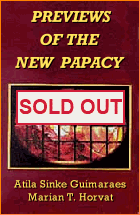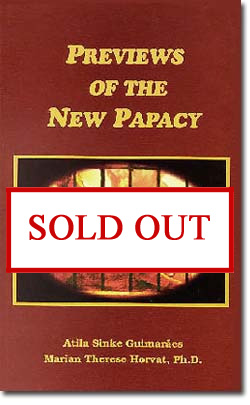Book Information
Atila Sinke Guimarães & Marian Therese Horvat, Ph.D. An honest presentation of some of the unusual activities of the post-Vatican II Popes. Nearly 500 pictures tell the story. A Special Edition to the Collection
La plus belle aventure du monde c’est la nôtre. [The most beautiful adventure of the world is ours.] This motto of Tradition in Action causes my thoughts to wander. I am transported to the glorious times of the First Crusade, to that age when men lived the Faith and were concerned above all with making the world an image of God and Paradise. In this spirit the cathedrals, hospitals, universities, castles, and social relations were established. This love for God, which wanted everything to be made in His image and give Him glory, had a consequence. The medieval man thought that God should also be glorified in the Holy Land. For him, there was nothing more important than that small part of the world, the place that had seen the birth of the Christ Child, the sand upon which the feet of Our Lord had walked, the mountains that had heard His voice, the rivers and streams that had quenched His thirst. The First Crusade, far from being something turned toward the persecution of this or that people, was above all an act of love, born from the need to protect the sacred places where Our Lord Jesus Christ had lived, suffered, died, and resurrected. The Crusade was not principally an act of conquest. Rather, it was an exploit rooted in the great love for God that medieval man had. There was an indisputable grace in the convocation of the First Crusade. The words of Blessed Urban II were accompanied by a special force that generated a supernatural contagion that moved the hearts of medieval men. Everything was put aside to free the Sepulchre of Christ. Deus vult! God desires it. With this spontaneous outcry, those who listened to the Pope’s appeal accepted his invitation to fight for the Holy Land, and this cry resounded throughout Europe. Until today its echoes have reached the ears of those who still have the same excellence of the spirit of Faith that belonged to medieval man. When the Holy Sepulchre had been freed and the Latin Kingdom of Jerusalem established, peace began to reign in Palestine. However, the enemy lurked to retake its former possessions. To protect and defend it, the Orders of Chivalry were founded. Perhaps the most important of them was the Knights Templar, which seemed to have inherited that same spirit of holy prowess that had led the Crusaders to conquer Jerusalem. One of their mottos was this: The most beautiful adventure in the world is ours. And rightly so. What could be more worthy of brave deeds and the spirit of adventure than to defend the Sepulchre of Christ? To preserve Christianity in the Holy Land? Nothing. If the Knights Templar represented a grace of the Crusades, their motto summarizes it. These are a few of my thoughts when I consider this noble theme. However, my meandering cannot be reduced to a mere nostalgia for the past. Today, unfortunately, we have a situation unprecedented in History. After the Ecumenical Council of Vatican II, the greatest work of destruction ever undertaken was initiated inside the Catholic Church. “The greatest catastrophe of History,” were the words of Professor Plinio Corrêa de Oliveira, a great counter-revolutionary scholar and historian. I have not made any special studies of History, but from what I am seeing around me in our days, I agree with this statement. When I picture Our Lord Jesus Christ based on the innumerable images I know and principally the Sacred Shroud of Turin, I imagine Him as a King. His dignity was that of King, his bearing, his way of walking or directing himself to the multitudes that followed Him were all kingly. When he dealt with the poor, the sick, the women and children, his goodness and kindness were characteristic of a Catholic King. Everything about Him reflected the royalty of His human nature. And, at times, anyone who closely observes that supreme dignity can glimpse traces of the divine dignity that shone through His royal human dignity. The Catholic Church is an institution that is the most perfect reflection of Our Lord. When I see this new Progressivist Church that calls itself Catholic, no matter how much good will and effort I exert, I do not see in it the image of the human and divine royalty of Jesus Christ. But I saw it before the Council. What changed? The answer is simple. Everything. In my view, these Prelates and scholars who have tried to convince us that the Church needs to put aside its royal countenance to present itself as poor in order to attract the poor do not understand the soul of the simple people, and I include myself in that number. The real people, the true poor are those who admire the beauty which they do not have. Only by means of this admiration do souls thus prepare themselves to see God in the next life. Those who revolt against the majesty, the royal dignity, and the solemnity of the Church are not the true poor. The Church does not need to adapt herself to them. Rather, she needs to convert them and reform them, so that when they die they do not suffer the shock of seeing the majesty of God Who will judge them. This ballyhooed adaptation of the Church to the poor seems more a pretext to destroy that which such progressivists hate – the royal character of Holy Mother Church. For me, to destroy this royal character is the greatest disaster that could take place. For this reason, I agree with the affirmation that I cited above. This revolution in the Church is the greatest catastrophe of History. If I am right, then we are living in an epoch that is more important than that “glorious springtime of Faith” which was the Middle Ages. We are living in a “sinister winter of the Faith.” What, then, could be more glorious than to fight for the restoration of the majestic face of the Catholic Church. Nothing seems more important for the glory of God, the exaltation of the Church, and the salvation of souls. Are there many who see this clearly and have conditions to fight so that this restoration might be realized effectively? No. But this should not discourage us. When the English pilots successfully defended London from the total destruction that threatened from the German assault, Churchill said this of those heroes: “Never did so many owe so much to so few.” Now something of this is repeated in much greater proportions. Isn’t this a grand adventure? Isn’t it the most beautiful adventure in the world? Yes. With one detail that greatly enriches it: we have the victory promised by Our Lady at Fatima: “In the end, my Immaculate Heart will triumph.” For this reason, I invite you to join us. You have the honor of participating in the most beautiful adventure in the world. From this perspective, TIA has the satisfaction of presenting to the public a new work. It is a book of photos, whose message speaks for itself. It is a work that paints a picture of the recent Pontificates – especially the present day one – and shows how they have distanced themselves from the way of being of the pre-Conciliar Popes. TIA thought it necesssary to offer this ensemble of photos to the Catholic public. They have the right to know what is happening in our beloved Catholic Church just as children have the natural right to know what is happening with their parents and family. The two authors – Atila Sinke Guimarães and Marian Therese Horvat – have worked like two crusaders to bring this work to light. I can testify to the enormous effort that they made. What material recompense are they asking? None. They have no financial interest or material benefits – they have ceded their rights as authors to TIA. Their recompense, like mine, is to serve the Catholic cause and to participate in this grand adventure. The reward is honor. Let us turn to the times of Faith. The great restoration begins at home. For its part, TIA, Inc., a non-profit organization, has the custom to offer its books at a price lower than the normal bookstore rates. Previews of the New Papacy is being launched at an especially low price. Thus, profit is not our objective. Once again, we are turned to the times of Faith. Finally, I would like to express my desire that the reader benefit from the work and to ask his support for the dissemination of its message.  print an order form and pay with cash/check Books | CDs | Home | Contact Us | Donate |







